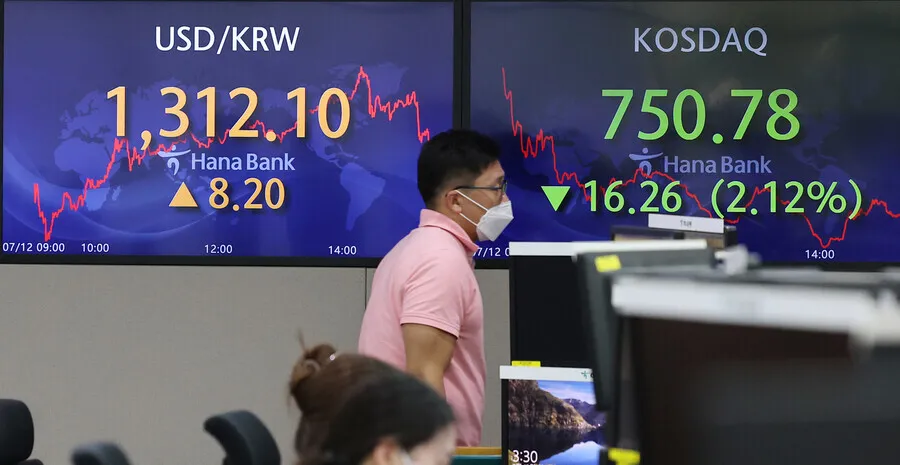hankyoreh
Links to other country sites 다른 나라 사이트 링크
Korean won falls to lowest point against dollar since 2009

The won-to-dollar exchange rate reached its highest level in a little over 13 years on Tuesday, with a peak of 1,316 during trading.
Among the factors pushing the dollar’s value upward are the employment booms in the US, projections of accelerating inflation, and the economic downturn in the eurozone.
In South Korea, the increased likelihood of the US policy interest rate overtaking South Korea’s by the end of the month has left the foreign exchange market facing a loss of funds from foreign investors and strain on the corporate bond market. Some market observers are even forecasting that South Korea could see exchange rates consistently above 1,300 won to the US dollar, as it did during the global financial crisis of the late ’00s.
On the Seoul foreign exchange market, the won reached as high as 1,316.4 to the dollar during trading on Tuesday — its highest peak since the global financial crisis, when it reached as high as 1,325.0 during trading on April 30, 2009. The closing value was 1,312.1 won to the dollar on Tuesday, up by 8.2 won from the day before.
Driving the decline in the won’s value is a rapid global increase in the value of the dollar, which is seen as the “last safe asset.” Factors in the dollar’s enormous strength right now include the swift and large-scale tight money measures being adopted by central banks in the US, Europe, South Korea, and elsewhere around the world, together with fears of economic recession.
The dollar index, indicating the ratio of the US dollar’s value to six other major currencies including the euro and yen, reached 108.5 at one point Tuesday. The euro dropped to parity, meaning that it is traded at an equivalent value to that of the dollar.
The euro’s value fell to US$1.0006 on Tuesday, reaching its lowest level since December 2002, Reuters reported. Analysts in the US are predicting the June consumer price index (CPI), which is set to be announced Wednesday evening Korea time, will climb as high as 8.8% compared with the same month in 2021 — an even sharper rise than the 8.6% observed last month.
Observers are also suggesting that the US Federal Reserve may respond to the rise in US employment indicators for June by considering not just a “giant step” — an interest rate hike of 75 basis points — but a “mega step” hike of 100 basis points or more during their next Federal Open Market Committee meeting on July 27.
Fundamental factors in the South Korean economy also appear to have played a part in the large interest rate rise Tuesday.
During June, South Korea recorded a net loss of US$780 million in investment stocks and bonds by foreign investors, with reports that even large corporations were pursuing bank loans as the domestic corporate bond issuance market contracts. These signals indicate concerns that the South Korean economy is poised to enter a period of contraction.
Also among the factors explaining the steep exchange rate rise are predictions that the US interest rate will overtake South Korea’s by the end of the month.
Currently, there is a difference of 0.00–0.25 percentage points between South Korea’s benchmark interest rate (1.75%) and the US’ (target range of 1.50–1.75%). If South Korea’s Monetary Policy Board raises the rate by just 0.25 percentage points Wednesday, that means that even with just a “big step” hike of 0.50 percentage points on July 27, the US would end up with a rate that’s 0.00–0.25 percentage points higher.
If this reversal happens, it is expected to further drive down the won’s value, as foreign investors in South Korea move over to the US while arbitrage traders take advantage of the difference in interest rates.
“The current won-to-dollar interest rate seems to already reflect predictions of a 0.5-percentage point hike in the benchmark rate, so if the actual hike is only 0.25 percentage points, there is a possibility the exchange rate could increase,” predicted Cho Young-moo, a research fellow at LG Business Research, an economic think tank.
By Cho Kye-wan, senior staff writer
Please direct questions or comments to [english@hani.co.kr]

Editorial・opinion
![[Correspondent’s column] Coupang’s game in Washington follows familiar pattern [Correspondent’s column] Coupang’s game in Washington follows familiar pattern](https://flexible.img.hani.co.kr/flexible/normal/500/300/imgdb/original/2025/1226/8217667391873536.jpg) [Correspondent’s column] Coupang’s game in Washington follows familiar pattern
[Correspondent’s column] Coupang’s game in Washington follows familiar pattern![[Editorial] Coupang’s attempt to hide behind US won’t win back Korean consumers [Editorial] Coupang’s attempt to hide behind US won’t win back Korean consumers](https://flexible.img.hani.co.kr/flexible/normal/500/300/imgdb/original/2025/1226/1817667387971465.jpg) [Editorial] Coupang’s attempt to hide behind US won’t win back Korean consumers
[Editorial] Coupang’s attempt to hide behind US won’t win back Korean consumers- Coupang under fire for possible obstruction of investigation into its customer data leak
- [Editorial] Coupang founder’s contempt for workers, customer security knows no bounds
- [Column] Confessions of a Coupang-holic
- [Editorial] Kim Bom-suk’s arrogance on full display in boycott of Coupang leak hearing
- [Editorial] The facts of Yoon’s insurrection are clear — justice cannot be further delayed
- [Column] Trump destroys government
- [Column] A post-Western world approaches
- [Column] Offshore balancing, or carving out spheres of influence?
Most viewed articles
- 1Korea to trial next-gen train capable of sub-2-hour Seoul-Busan trip starting 2030
- 2Kim Jong-un’s hidden motive in criticizing South Korea’s nuclear submarine push
- 3[Editorial] Coupang’s attempt to hide behind US won’t win back Korean consumers
- 4Coupang under fire for possible obstruction of investigation into its customer data leak
- 5[Correspondent’s column] Coupang’s game in Washington follows familiar pattern
- 6Real-life heroes of “A Taxi Driver” pass away without having reunited
- 7Moon Jae-in renews call for end-of-war declaration, peace treaty on Korean Peninsula
- 8Chang Chun-ha’s family hopes to know truth of his death after 37 years
- 9Chinese money flooding into South Korean companies
- 10Russian architect personally witnessed Empress Myeongseong’s assassination by Japanese ronin, accoun